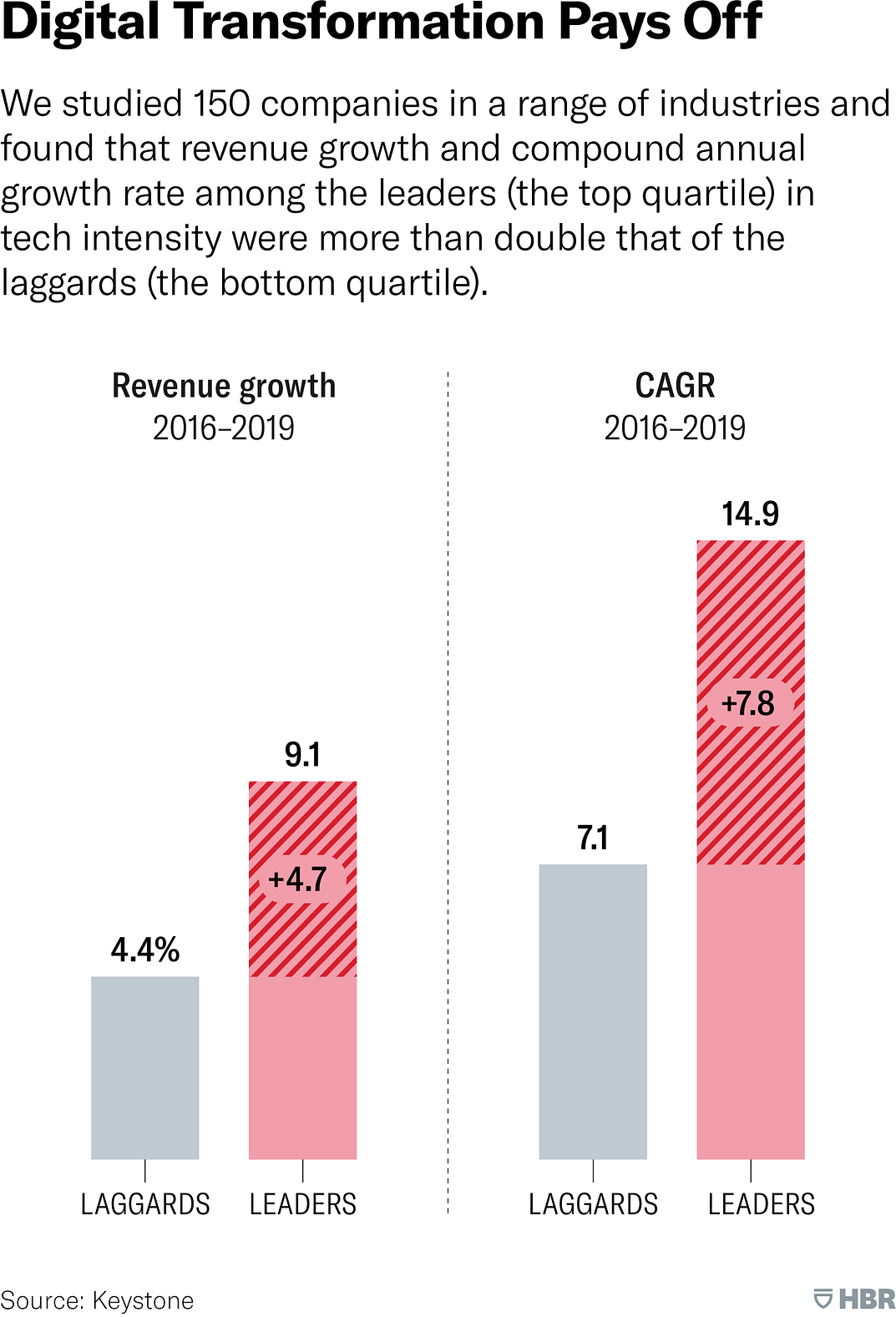This is a republication of the article below, with the title above, with a focus on the topic in question.
Democratizing Transformation — The case of Novartis and Microsoft
And the results of a 150 organizations survey
Harvard Business Review
by Marco Iansiti and Satya Nadella
From the Magazine (May–June 2022)
Summary.
Many companies struggle to reap the benefits of investments in digital transformation, while others see enormous gains. What do successful firms do differently?
This article describes the five stages of digital transformation, from the traditional stage, where digital and technology are the province of the IT department, through to the platform stage, where a comprehensive software foundation enables the rapid deployment of AI applications.
The ideal is the native stage, whose hallmarks are an operating architecture designed to deploy AI at scale across a huge, distributed spectrum of applications; a core of experts; broadly accessible, easy-to-use tools; and investment in training and capability-building across the enterprise.

Staging the Transformation (excerpt)
Our analysis confirms that just spending money on technology does not result in more growth or better performance; in fact, in some cases it can actually damage the business if it accentuates divisions and inconsistencies across groups.
Instead, it is the architectural, managerial, and organizational approaches to transformation that best explain the substantial and enduring differences among firms.
We found that companies typically progress through five stages on their transformation journey.
- Traditional model.
- Bridge model
- Hubs Model
- Platform model
- Native model
Over the past five years, Microsoft has gone through almost every stage of this journey.
Years ago, we were just as siloed as most companies, with each product-based organization segregating its own data, software, and capabilities.
Years ago, Microsoft were just as siloed as most companies, with each product-based organization segregating its own data, software, and capabilities.
As we connected and normalized data from different functions and product groups, we were able to deploy integrated solutions in areas ranging from customer service to supply-chain management.
We integrated all our data in a companywide data lake, and we built what we call a business process platform, which provides software and analytics components that teams use to enable innovation in areas ranging from Xbox manufacturing to managing advertising spend.
We also invested in training programs for nontechnical employees, cultivating data-centric and machine-learning capabilities throughout the organization.
…. Microsoft integrated all data in a companywide data lake, and built a business process platform …
… they also invested in training programs for nontechnical employees, cultivating data-centric and machine-learning capabilities throughout the organization.
At Microsoft, we still have a lot to learn, but in some parts of the organization we are starting to approach the native model.
As is common in any enterprise, the progress has not been uniform.
Different groups have achieved different levels of capability, but the results overall are encouraging, as we see increasingly innovative solutions to internal and customer-facing problems.
Most critically, our companywide approach to understanding, protecting, and working with data has progressed by light years.

The Success Drivers (excerpt)
Our research shows that to enable transformation at scale, companies must create synergy in three areas:
1.Capabilities.
Successful transformation efforts require that companies develop digital and data skills in employees outside traditional technology functions.
These capabilities alone, however, are not sufficient to deliver the full benefits of transformation; organizations must also invest in
- developing process agility and,
- more broadly, a culture that encourages widespread, frequent experimentation.
2.Technology.
Of course, investment in the right technologies is important, especially in the elements of an AI stack: data platform technology, data engineering, machine-learning algorithms, and algorithm-deployment technology.
Companies must ensure that the technology deployed is easy to use and accessible to the many nontechnical employees participating in innovation efforts.
3.Architecture.
Investment in organizational and technical architecture is necessary to ensure that human capabilities and technology can work in synergy to drive innovation.
That requires an architecture-for both technology and the organization-that supports the sharing, integration, and normalization of data (for example, making data definitions and characteristics consistent) across traditionally isolated silos.
This is the only real, scalable way to assemble the necessary technological and data assets so that they are available to a distributed workforce.
Building Tech Intensity (excerpt)
Our research unpacks how capabilities, technology, and architecture work together to build what we call tech intensity.
(See the exhibit “Digital Transformation Pays Off.” To score your firm’s tech intensity, go to www.keystone.ai/techintensity.)

We also found that technology, capability, and architecture indices correlated with other measures of performance, from productivity and profits to growth in enterprise value.

The Imperative for Leaders
The mandate for digital transformation creates a leadership imperative:
- Embrace transformation, and work to sustain it.
- Articulate a clear strategy and communicate it relentlessly.
- Establish an organizational architecture to evolve into as you make the myriad daily decisions that define your technology strategy.
- Deploy a real governance process to track the many technology projects underway, and coordinate and integrate them whenever possible.
- Champion agility in all business initiatives you touch and influence. And finally, break free of tradition.
- Train and coach your employees to understand the potential of technology and data, and release the innovators within your workforce.
This mandate extends to technology providers.
Despite much investment, technologies are still too complex and are often too hard to use and deploy.
We need tools and technology that make driving transformation intuitive for frontline workers while keeping data secure.
Let’s not forget that until recently many of us were relying on specialists in Fortran and Cobol to model business problems and even to perform basic mathematical operations.
Spreadsheets brought about a revolution in mathematical modeling; we need technology providers to bring the same revolution to AI and make using a machine-learning application as easy as creating a pivot table.
Momentum is growing. But we must sustain the efforts to ensure that companies of all stripes make it across the digital divide.
A version of this article appeared in the May-June 2022 issue of Harvard Business Review.
Originally published at https://hbr.org on May 1, 2022.

Idea in Brief
The Problem
Many companies struggle to reap the benefits of investments in digital transformation, while others see enormous gains. What do successful companies do differently?
The Journey
This article describes the five stages of digital transformation, from the traditional stage, where digital and technology are the province of the IT department, through to the platform stage, where a comprehensive software foundation enables the rapid deployment of AI-based applications.
The Ideal
The ideal is the native stage, whose hallmarks are an operating architecture designed to deploy AI at scale across a huge, distributed spectrum of applications; a core of experts; broadly accessible, easy-to-use tools; and investment in training and capability-building among large groups of businesspeople.
TAGS:
Digital Capabilities; Digital Technology; Digital Architecture; Key Success
About the authors
Marco Iansiti
David Sarnoff Professor of Business Administration,is a codirector of the Laboratory for Information Science at Harvard and of the
Digital Initiative at HBS.
Satya Nadella
Chairman and CEO at Microsoft
Names mentioned
Chief digital officer Bertrand Bodson, Novartis;
Eric von Hippel of MIT;
Victor Bulto, Novartis’s head of U.S. pharmaceuticals;
Lori Beer, JPMorgan Chase’s global CIO,
CEO Kevin Johnson, Starbucks












